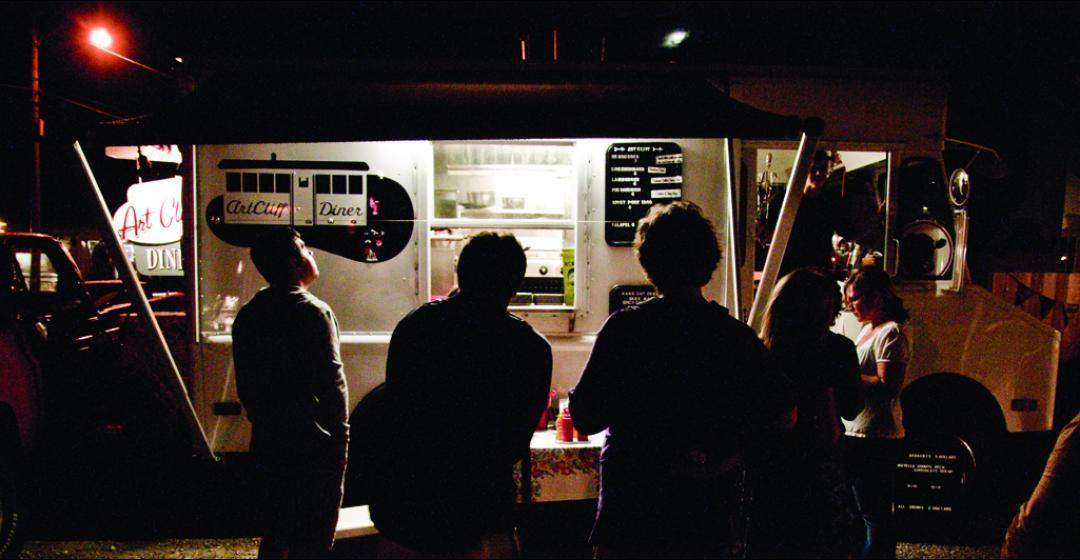Lately food trucks are all the rage but they’re hardly a new idea. Cowboys driving cattle in the 1800s had what were probably the first food trucks – they called them chuck wagons. In the 1890s lunch wagons did a good business catering to late-night workers. And of course mobile food trucks have been around for years, serving up food at construction sites.
When the recent recession hit, the construction business dried up and suddenly a lot of food trucks were on the market. Coincidentally, a lot of chefs at high-end restaurants were being laid off and it didn’t take long for the trucks and the chefs to come together.
Gina Stanley, owner of the ArtCliff Diner in Vineyard Haven, has been operating a food truck on the Island for six years – you can often see it parked out in front of her diner. Which begs the question: why a food truck when you already have a diner?
“I’ve always loved old diner cars,” explains Stanley, “and the food truck is kind of a spin-off on that. Plus, I really can’t do breakfast, lunch, and dinner in the diner – it’s just too small. I need to be doing the prep in the kitchen at night for the next day.” So a food truck was the answer.
If you search online you can find used food trucks for under $10,000 and tricked out new ones for well over $100,000. Forbes Magazine says that a reasonable cost for finding a good used truck remodeled to suit your specific needs is roughly $60,000.
The most expensive trucks are essentially self-sufficient; all cooking and prep work can be done on board. But many trucks get by with less by using an off-site kitchen. Local chef Josh Aronie ran The Food Truck this past winter in Chilmark and used the commercial kitchen of Island caterer Jan Buhrman. And of course Stanley has access to her own kitchen at the ArtCliff.
“I went down to this place in New Jersey that sold food trucks; they were just starting to become popular. They had all these shiny new trucks with all sorts of equipment in them. But I fell in love with an old postal truck with just one cooler in it; they had been selling ice cream out of it. I had them build in equipment to my specifications. They painted it and put the graphics on it and they delivered it in the summer of 2008.”
Stanley’s truck has two large refrigerators, a flat-top grill, a fryer, and a sink. She uses her commercial kitchen in the diner to prep the food, which is then packaged and refrigerated in the truck. Typically she’ll have to replenish supplies throughout the night from the diner kitchen. The truck is a three-man operation: two cooks inside and one person taking orders. In addition there are one or two people inside the kitchen prepping.
Stanley will tell you, running a food truck is no cakewalk. “I don’t think a lot of people realize how much work goes into doing the food prep, setting the truck up, and then at the end of the night cleaning the grill, scrubbing the floors, taking food out, and putting it in new containers . . . it takes us roughly two and a half hours to set up and just about as long to clean up afterward. So on Friday or Saturday, we close up at two a.m. and don’t get out
until four or so and then we open the diner at six a.m. It’s a grind in the summer.”
Stanley’s advice for running a food truck is to keep it simple. She’ll generally offer about twelve to fifteen items on the menu: burgers, hot dogs, some specialty sandwiches like pork tacos or Cubans, falafel, and donuts and whoopie pies for dessert.
And unlike running a food truck in some big cities, where permitting and regulations can be particularly onerous, the licensing is relatively streamlined
here on the Island. You need a food peddler’s license for whatever town you’re operating in and a commercial certification for the kitchen where you’re preparing your food.
On Thursday through Sunday nights throughout the summer and on weekends well into the fall, you’ll find the ArtCliff food truck open for business out in front of the diner. Other nights it often shows up at private parties, weddings, and fundraisers. And where you find the food truck you generally find Stanley. What’s her secret for running both the truck and the diner – two jobs, each of which most people would consider full time?
“For three months out of the year I just don’t come up to breathe.”







